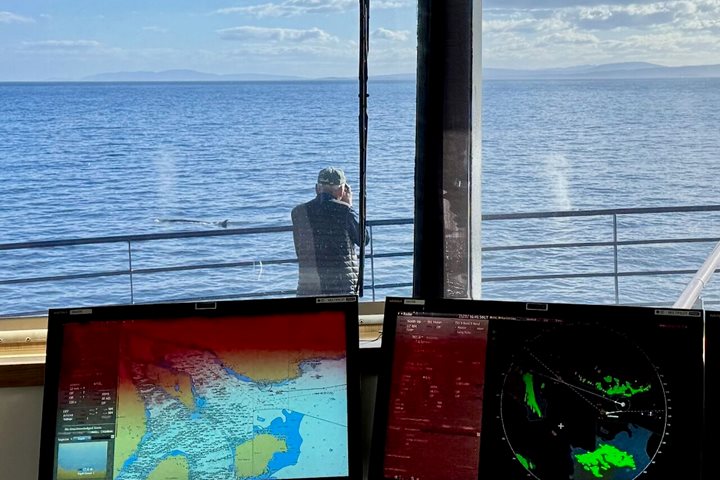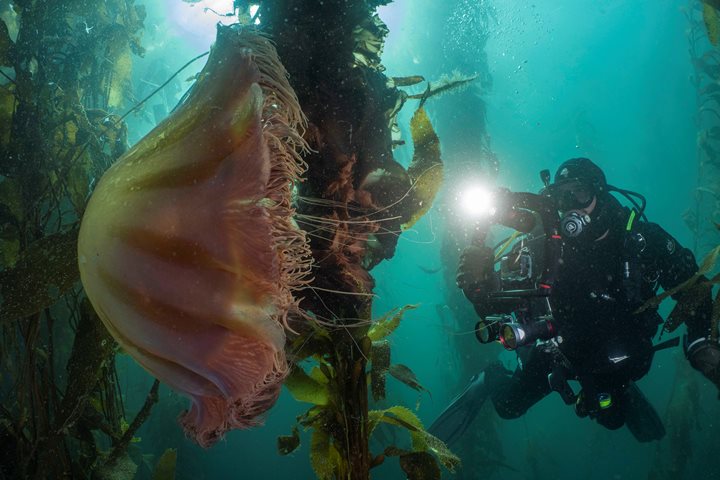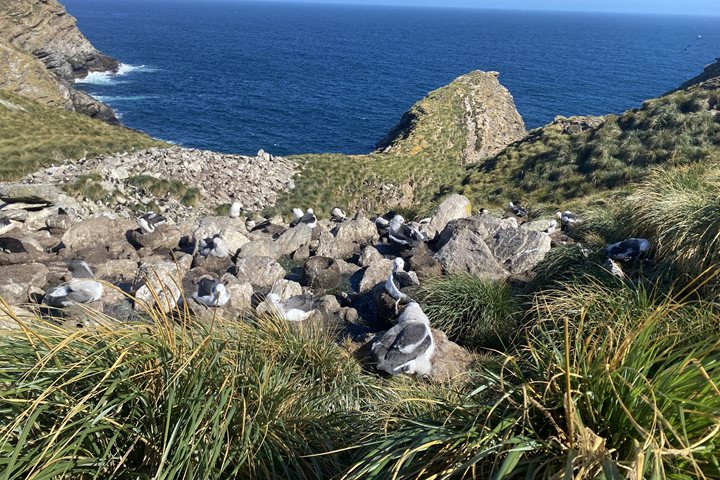They say the Falklands are a windy place and after today, we believe them. Last night was a bumpy evening heading towards the Falkland Islands, and today we awoke to find National Geographic Onion anchored off the east coast of Bleaker Island. This low island provided only modest shelter from the screaming westerly winds that thrashed the island and had our Zodiac drivers showing off their deft skills, safely delivering us to a white sandy beach. Here we secured our hats and coats against the wind and headed out for a long hike across rolling farmland. Fluffy sheep and newborn lambs dotted the green paddocks and in many places we found upland geese hunkered down on their nests, keeping a low profile to avoid being blown away to the east. Two-banded plovers also nest here and in one instance a bird feigned a broken wing in an elaborate dance intended to lead us away from its nest. We quickly obliged. Further on, the hike reached the coastal cliffs where we found 850 pairs of rockhopper penguins sitting on their cliff-edge nests. The narrow fringe of tall tussock grass gave them some shelter from the wind and we caught glimpses of eggs tucked up underneath the incubating adults. Our morning finished, we boated back to the ship as increasing wind scoured sand off the beach. Our final destination – Stanley – awaits us this evening and tomorrow.
- Daily Expedition Reports
- 05 Nov 2016
Bleaker Island, Falkland Islands, 11/5/2016, National Geographic Orion
- Aboard the National Geographic Orion
- Antarctica
Peter Carey, Expedition Leader
Peter is a New Zealand zoologist who has worked as a scientist and tour leader in Antarctica and the subantarctic islands since 1983. He is currently doing ecological restoration work on a group of small islands he has purchased in the Falklands arch...
Read MoreShare Report
South Georgia and the Falklands
VIEW ITINERARYRelated Reports
3/14/2025
Read
National Geographic Resolution
New Island, Falkland Islands
Our final day of operations for the expedition (and the season) took place at New Island, one of the most beautiful islands in the Falkland Islands. Guests were amazed by the sheer cliffs of the outer coast, home to thousands of rockhopper penguins and even more black-browed albatross. While guests were ashore, the undersea team explored the underwater world of the Falkland Islands. We cruised through the amber forest of giant kelp and photographed the large sun stars but also some of the smaller denizens like tessellated patagonotothen fishes and beautiful purple-lined isopods. The highlight of the dive was one of the largest jellies either of us had seen. A gargantuan lion’s mane jelly was wrapped up in the kelp and its bell was almost 4 feet across. Truly a sight to behold and a favorite when shown to the guests at recap.
3/13/2025
Read
National Geographic Resolution
West Point Island
Our destination this afternoon remains my very favorite place in the Falklands. A warm welcome is always given by the caretakers of this lovely place, Theis and Kiki – Swedish and German respectively. They were at the end of their nine years here and we were among the last ships to visit this season. Of course, we visit the island because of the wildlife, and, after a nice forty-minute walk, we arrived at the Devil’s Nose albatross colony. Here, we found thousands of black-browed albatrosses living cheek by jowl with hundreds, if not thousands of rockhopper penguins. It is not always a happy marriage, but generally they get on, the albatross helping protect the penguin eggs and chicks from predation by the local Johnny rooks aka striated caracaras. A good walk deserves a fine afternoon tea, and we were treated to just that back at the farmhouse. In the garden, a yellow rose flowered beautifully overlooking the place where Lars Eric Lindblad’s ashes were scattered.







